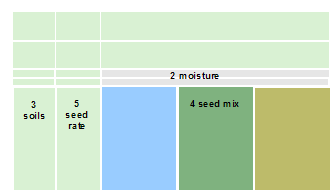Chapter 6: Choose Species/Cultivars for Revegetation Projects
Instructions for Revegetation Suggestions Charts
- Select region of state based on the map below.

- Estimate the soil moisture conditions at the site.
- Select the soil type based on standard engineering soil classification (Table 2).
- Select an effective seed mix from the three categories (It is always prudent to use more than one selection in a seed mix.
Remember, it is called a mix; implying more than one component)

All entries are listed in order of preference. Listing in order of
recommendation gives the designer guidance to prudently select
species based on local preference and availability, as well as the
secondary consideration of cost.
- “Category 1” species should account for 80–100% of the seed mix.
If the site is approximately uniform with regard to soil
conditions, a two- to three-species mix of exclusively
category 1 species suffices.
Conversely, if soil conditions vary considerably, category 1
species should comprise the lower end of the percent
range.
- “Category 2” species give variety to the mix, allowing the designer to
cover a broad range of variable conditions.
- “Category 3” usually includes species in short supply or of high cost. Category 3 material adds the highest degree of variability to the mix and may also be recommended when special
concerns about environmental issues, such as stream
crossings, are encountered.
Category 3 material should not exceed 5% of the total mix,
and its portion should reduce the category 1
percentages, not category 2.
An example:
For a project in the Southcentral region with average soil
moisture and SW soils, ‘Norcoast’ Bering hairgrass can
form 60% of the category 1 portion of the mix.
Another category 1 species should comprise 20–40% of the
mix, depending on variability of soil type.
If the second species comprises less than 40% of the mix,
category 2 or possibly category 3 species are used to
bring the total to 100%.
Wainwright Germplasm slender wheatgrass is the highest
recommended category 2 species, followed by ‘Boreal’
red fescue in this specific example.
- Seeding rates for the entire mix are listed in the column “Seed Rate”. This number is interchangeable for either pounds per acre or kilograms
per hectare.
- If the site is determined to be an erosion hazard, add no more than 10%
annual ryegrass to the previously developed mix. The species, while
giving temporary erosion protection, competes for nutrients with the longterm
perennial species. Also, annual ryegrass is a highly palatable and
attractive forage species that can attract herbivores (i.e. moose and deer).
Determining Regions
If your project lies near regional boundaries and you cannot
determine what region’s specifications should be used, follow
these guidelines:
Arctic—Interior:
Use Interior
Arctic—Western:
Use Western
Western—Interior:
Use Interior
Western—Southwestern:
Use Western
Western—Southcentral:
Use Southcentral
Southwestern—Southcentral: Use Southcentral
Southcentral—Interior:
Use Interior
Southcentral—Southeast:
Use Southcentral
|


